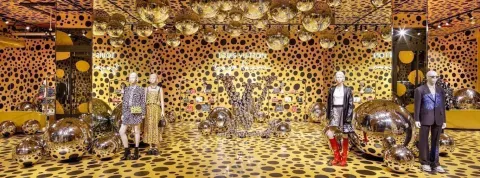
Art and Luxury: Foundations and Brand Strategy
From Elsa Schiaparelli, who collaborated with Salvador Dalí in the 1930s, to Christian Dior, once a gallery owner, and the legendary art collection of Yves Saint Laurent, the relationship between art and luxury is a long-standing and passionate story. More than a simple dialogue, luxury and art have become the very essence of certain maisons, where each creation is elevated to the rank of luxury art symbols of excellence, creativity, and emotion.
A historical link between luxury houses and art
Although the era of Medici-style patrons is over, corporate sponsorship today translates into investments by major luxury players in private foundations, artist retrospectives, dedicated showrooms, and brand presence at major international art fairs.
Some are discreet, like the Boghossian Foundation and the Villa Empain in Belgium (a tribute to Art Deco architecture and to Eastern and Western cultures), or the Hermès Corporate Foundation, which supports craftsmanship; and others are more media-facing, like the Louis Vuitton Foundation in Paris, the Fondazione Prada in Milan, or the pioneers such as the Cartier Foundation, created in 1984 in Paris. As a place for encounters and dialogue around contemporary art, it paved the way for French cultural sponsorship.
As Thibaut de La Rivière, Director of Sup de Luxe, notes: “Luxury and art are inseparable, and we must continue to build bridges between these worlds.” For luxury brands, sponsorship or the creation of their own foundations is a logical and natural extension of the excellence they offer their clients.
Today, the product alone is no longer enough. The luxury industry and its brands must now more than ever embody character and a unique identity to convey values that resonate with the client.
Art is a perfect vector of emotion and message, and it subtly reflects a brand’s positioning especially contemporary art, which can even be defined as “the art of communication.” It carries an elitist image because it is seen as “intellectual” while breaking away from established principles and codes.
A kind of “luxury rebel,” and thus an ideal ground for major maisons, always seeking new communication channels. Moreover, it allows them to gain an innovative image among international clientele, especially in a globalized context.
For those who wish to better understand this alchemy between art and luxury, the Sup de Luxe Bachelor in Luxury offers a program dedicated to the world of luxury and culture.
Sponsorship today: foundations and partnerships
Louis Vuitton Foundation
Inaugurated in 2014 in Paris, the Louis Vuitton Foundation is one of LVMH Group’s most ambitious cultural projects. Designed as a futuristic vessel by architect Frank Gehry, it embodies Bernard Arnault’s commitment to contemporary creation. The foundation offers a major international program: concerts, performances, conferences, and above all, exhibitions by major artists, such as the current “David Hockney 25” exhibition.
Fondazione Prada
In Milan, the Fondazione Prada explores dialogues between contemporary art, architecture, and culture in general. Founded in 1993 by Miuccia Prada and Patrizio Bertelli, it opened a spectacular new site in 2015 designed by Rem Koolhaas. The foundation offers an eclectic program, ranging from visual art exhibitions to research in philosophy, cinema, and literature.
Hermès Corporate Foundation
Created in 2008, the Hermès Corporate Foundation stands out through its artisanal and human approach to sponsorship. True to the maison’s values of excellence and transmission, it supports contemporary creation in all forms (visual arts, performing arts, design) while promoting craftsmanship and training.
Cartier Foundation for Contemporary Art
A pioneer in the field, the Cartier Foundation for Contemporary Art was created in 1984. Since 1994, it has been housed in a glass and steel building designed by Jean Nouvel, and it defends a program open to the most diverse expressions: visual arts, photography, design, cinema, music, and even science. Cartier cultivates a spirit of freedom and discovery there, encouraging encounters between artists and the public.
Other initiatives
Other major luxury houses are also actively contributing to the global artistic landscape. Chanel, for instance, supports contemporary creation through its “Chanel Culture Fund,” which finances innovative artistic projects worldwide. Dior, meanwhile, multiplies artistic collaborations, regularly inviting artists to reinterpret its creative heritage, as in the Dior Lady Art exhibitions. Boucheron, a historic maison on Place Vendôme, is involved in sponsorships linked to architecture and heritage monument restoration.
Contemporary art, a lever for differentiation
In a luxury world where exception is the norm, contemporary art has become a powerful lever for differentiation. By associating with avant-garde artists, luxury maisons cultivate an image of innovation, creativity, and boldness. This proximity with art not only sets them apart from competitors but also enriches their brand identity with a strong cultural dimension.
Whether through exhibitions, collaborations on unique pieces, or large-scale architectural projects, contemporary art brings a “soul bonus” to brands. It offers them the opportunity to tell new stories, surprise their clients, and win over new generations drawn to creation and artistic engagement.
Why does art appeal to luxury brands?
Luxury and art have always shared common values: excellence, innovation, emotion, and the quest for timelessness. This natural link explains why art is so appealing to great maisons. By associating with the artistic world, they enhance their image with a cultural, creative, and intellectual dimension that transcends simple products.
Art also allows luxury brands to enrich their storytelling, embody a vision of the world, and engage with a clientele sensitive to authenticity and aesthetic experimentation. It’s also a way to project themselves into the future, by capturing emerging trends while affirming their role as cultural trailblazers.
By investing in art, luxury maisons are not only seeking immediate gain, but a return on investment rich in symbolic and cultural value. Through sponsorship, foundations, and artistic collaborations, they strengthen their identity, cultivate their uniqueness, and embed their history in a dynamic of ongoing creation. This artistic commitment appears as a long-term investment, serving their influence and longevity a strategy studied in our MSc Global Luxury Brand Management program, designed to train future leaders in luxury in these cultural and economic challenges.
Are you interested in fashion in the luxury sector? Come and meet us to ask your questions and find out more about our training programmes.
Interested in luxury watchmaking?
Aucun résultat trouvé
